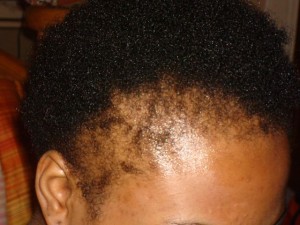The American Health Journal reports that hair loss affects 21 million women in the United States. Female pattern baldness is the most common cause of hair loss in women. Though this chronic, genetic-based condition rarely leads to baldness and does not cause a receding hairline as it does with men, hair thins over the entire head. Non-genetic factors also increase hair loss in women much more than men, such as traction alopecia hair loss.
When people experience loss of volume or hair thinning, they may experience negative self-esteem and diminished self-confidence. In order to treat hair loss and balding, one must first underlying causes.

Causes of Hair Loss in Women of Color
Those of Africans descent typically express cultural aspects with their hair with the extensive use of tools, conditioners, relaxers and other chemical processes. In addition to female pattern baldness, two types of alopecia are:
- Traction alopecia
- Central cicatricial centrifugal alopecia (CCCA)
Both conditions are the direct result of the ongoing treatment of hair and self-inflicted causes of hair loss. Traction alopecia is the gradual hair thinning from frequent, forceful and chronic hair pulling. It may also cause recession around the edges of the scalp. Causes include tight braids, weaves and extensions from styles commonly found by African-American women. The condition is also known as traction hair loss.
Difference in African Hair Loss Treatment
Though those of African descent experience pattern baldness less than Caucasians, it is still the main cause of hair loss. Traction alopecia is also a major cause of hair loss. This cause is self-inflicted from gradual hair thinning from frequent, forceful pulling. Causes include tight braids, cornrows, weaves and extensions from styles commonly found by African-American women.
Self-Imposed Hair Loss
Prevalent hairstyles by African-American women can cause non-genetic, such as traction alopecia. Traction alopecia occurs from continuous, repeated pulling of hair and result with noticeable thinning occurs along the entire scalp periphery. Traction alopecia hair loss also contributes to CCCA in addition to the use of hair chemicals. The hair follicle composition is weakened with repeated treatments, leading to a reduction in strength and more breakage. Heated styling appliances also aggravate CCCA.
TREATING TRACTION ALOPECIA HAIR LOSS IN WOMEN
For non-genetic hair loss such as traction alopecia hair loss, preventative measures are the best option. This includes:
- Improving overall health
- Minimizing scalp irritation
- Decreasing continued hair pulling
When traction alopecia hair loss and CCCA are no longer reversible, a few options can address hair restoration. Different methods of female hair restoration may be used to address hair loss such as follicular unit extraction.
Related Reading
Hair Loss In African American Women
